2012 BMW 535I GRAN TURISMO child restraint
[x] Cancel search: child restraintPage 45 of 321

▷ Press the switch beyond the resist‐
ance point.
The window opens automatically.
Pressing again stops the motion.
Convenient opening, refer to page 34, via the
remote control.
Closing Danger of pinching
Monitor the closing process and make
sure that the closing path of the window is clear;
otherwise, injuries may result.◀
▷ Pull the switch to the resistance point.
The window closes while the switch is held.▷ Pull the switch beyond the resistance
point.
The window closes automatically.
Pressing the switch stops the motion.
Convenient operation, refer to page 34, via the
remote control.
Convenient closing, refer to page 42, with Com‐
fort Access.
Pinch protection
If the closing force exceeds a specific value as a
window closes, the closing action is interrupted.
The window reopens slightly.
Danger of pinching even with pinch pro‐
tection
Even with the pinch protection system, check
that the window's closing path is clear; other‐
wise, the closing action may not stop in certain
situations, e.g., if thin objects are present.◀
No window accessories
Do not install any accessories in the range
of movement of the windows; otherwise, the
pinch protection system will be impaired.◀
Closing without the pinch protection
system
Danger of pinching
Monitor the closing process and make
sure that the closing path of the window is clear;
otherwise, injuries may result.◀
For example, if there is an external danger or if
ice on the windows prevents a window from
closing normally, proceed as follows:1.Pull the switch past the resistance point and
hold it there.
Pinch protection is limited and the window
reopens slightly if the closing force exceeds
a certain value.2.Pull the switch past the resistance point
again within approx. 4 seconds and hold it
there.
The window closes without pinch protec‐
tion.
Safety switch
The following functions can be locked simulta‐
neously, using the switch:
▷Opening and closing of the rear windows
using the switches in the rear.▷Operation of the roller sunblinds using the
switches in the rear.▷Adjustment of the power rear seats.▷Adjustment of the power head restraints in
the rear.
Switching on and off
Press the button.
The LED lights up if the safety function
is switched on.
Safety switch for rear operation
Press the safety switch when transporting
children in the rear; otherwise, injury may result
if the windows are closed without supervision. ◀
Seite 45Opening and closingControls45
Online Edition for Part no. 01 40 2 607 855 - 09 11 490
Page 63 of 321
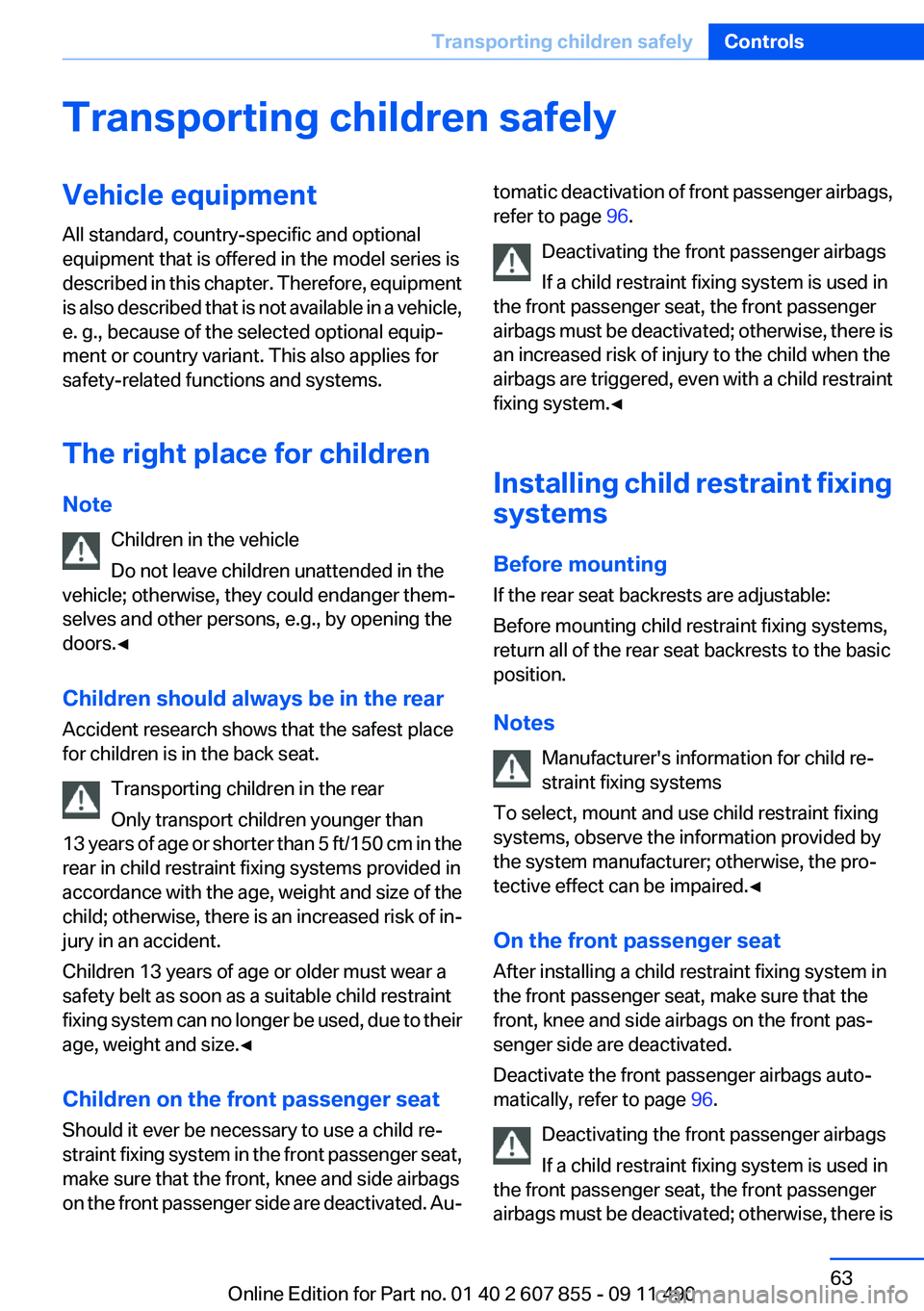
Transporting children safelyVehicle equipment
All standard, country-specific and optional
equipment that is offered in the model series is
described in this chapter. Therefore, equipment
is also described that is not available in a vehicle,
e. g., because of the selected optional equip‐
ment or country variant. This also applies for
safety-related functions and systems.
The right place for children
Note Children in the vehicle
Do not leave children unattended in the
vehicle; otherwise, they could endanger them‐
selves and other persons, e.g., by opening the
doors.◀
Children should always be in the rear
Accident research shows that the safest place
for children is in the back seat.
Transporting children in the rear
Only transport children younger than
13 years of age or shorter than 5 ft/150 cm in the
rear in child restraint fixing systems provided in
accordance with the age, weight and size of the
child; otherwise, there is an increased risk of in‐
jury in an accident.
Children 13 years of age or older must wear a
safety belt as soon as a suitable child restraint
fixing system can no longer be used, due to their
age, weight and size.◀
Children on the front passenger seat
Should it ever be necessary to use a child re‐
straint fixing system in the front passenger seat,
make sure that the front, knee and side airbags
on the front passenger side are deactivated. Au‐tomatic deactivation of front passenger airbags,
refer to page 96.
Deactivating the front passenger airbags
If a child restraint fixing system is used in
the front passenger seat, the front passenger
airbags must be deactivated; otherwise, there is
an increased risk of injury to the child when the
airbags are triggered, even with a child restraint
fixing system.◀
Installing child restraint fixing
systems
Before mounting
If the rear seat backrests are adjustable:
Before mounting child restraint fixing systems,
return all of the rear seat backrests to the basic
position.
Notes Manufacturer's information for child re‐
straint fixing systems
To select, mount and use child restraint fixing
systems, observe the information provided by
the system manufacturer; otherwise, the pro‐
tective effect can be impaired.◀
On the front passenger seat
After installing a child restraint fixing system in
the front passenger seat, make sure that the
front, knee and side airbags on the front pas‐
senger side are deactivated.
Deactivate the front passenger airbags auto‐
matically, refer to page 96.
Deactivating the front passenger airbags
If a child restraint fixing system is used in
the front passenger seat, the front passenger
airbags must be deactivated; otherwise, there isSeite 63Transporting children safelyControls63
Online Edition for Part no. 01 40 2 607 855 - 09 11 490
Page 64 of 321

an increased risk of injury to the child when the
airbags are triggered, even with a child restraint
fixing system.◀
Seat position and height
Before installing a child restraint fixing system,
move the front passenger seat as far back as
possible and bring it up to medium height to ob‐
tain the best possible position for the belt and to
offer optimal protection in the event of an acci‐
dent.
Do not change the seat position and height after
this.
Backrest width
Before installing a child restraint fixing system in
the front passenger seat, open the backrest
width completely. Do not change the backrest
width again and do not call up a memory posi‐
tion.
Backrest width for the child seat
Before installing a child restraint fixing
system in the front passenger seat, the backrest
width must be opened completely. Do not
change the adjustment after this; otherwise, the
stability of the child seat will be reduced.◀
Child seat security
The rear safety belts and the front passenger
safety belt can be locked against pulling out for
mounting the child restraint fixing systems.
Locking the safety belt
1.Pull out the belt webbing completely.2.Secure the child restraint fixing system with
the belt.3.Allow the belt webbing to be pulled in and
pull it taut against the child restraint fixing
system. The safety belt is locked.
Unlocking the safety belt
1.Unbuckle the belt buckle.2.Remove the child restraint fixing system.3.Allow the belt webbing to be pulled in com‐
pletely.
LATCH child restraint fixing
system
LATCH: Lower Anchors and Tether for Children.
Note Manufacturer's information for LATCH
child restraint fixing systems
To mount and use the LATCH child restraint fix‐
ing systems, observe the operating and safety
information from the system manufacturer; oth‐
erwise, the level of protection may be reduced. ◀
Mounts for the lower LATCH anchors Correctly engage the lower LATCH an‐
chors
Make sure that the lower LATCH anchors have
properly engaged and that the child restraint fix‐
ing system is resting snugly against the back‐
rest; otherwise, the degree of protection offered
may be reduced.◀
Before mounting the LATCH child restraint fix‐
ing system, pull the belt away from the child re‐
straint fixing system.
Seite 64ControlsTransporting children safely64
Online Edition for Part no. 01 40 2 607 855 - 09 11 490
Page 65 of 321
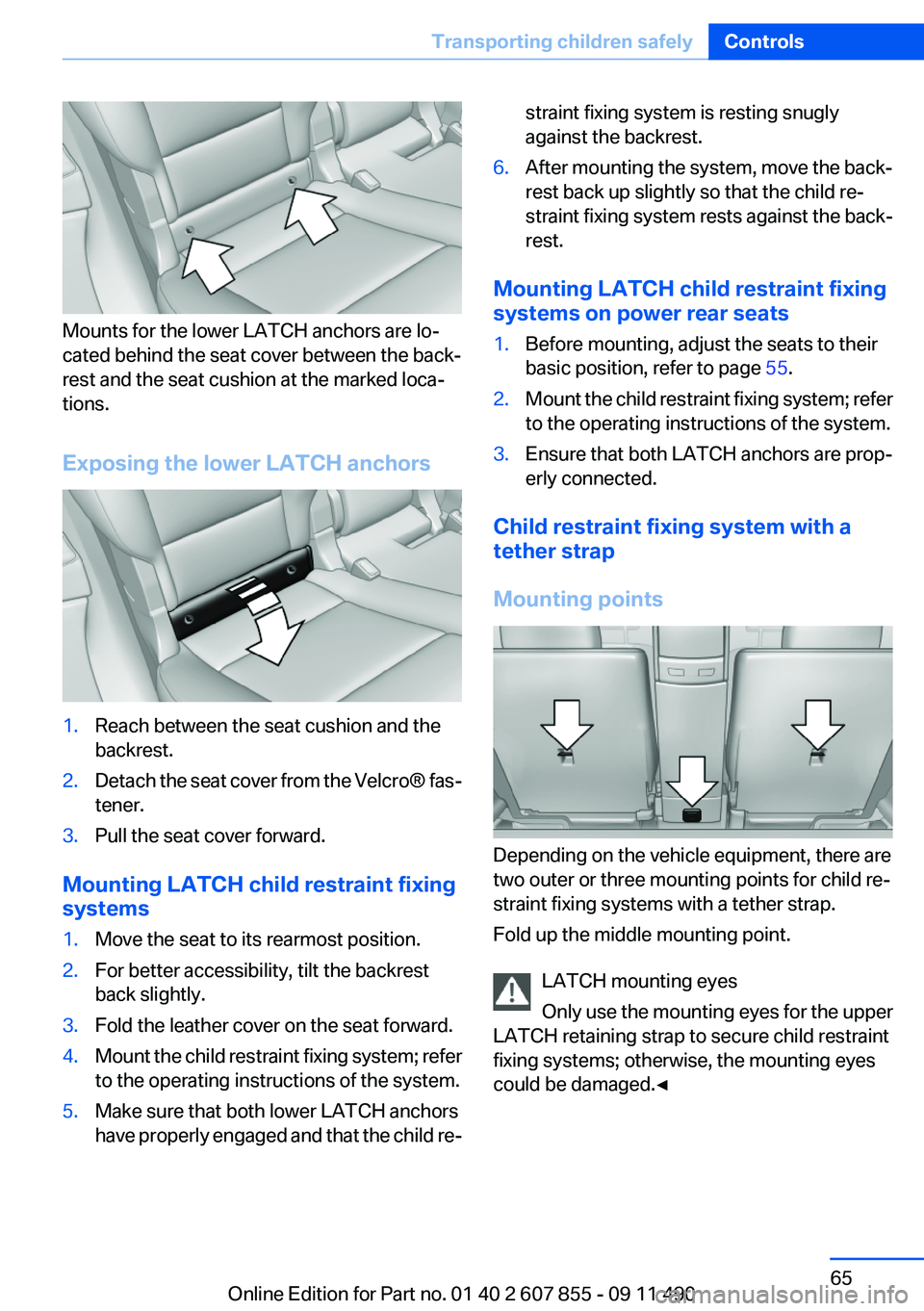
Mounts for the lower LATCH anchors are lo‐
cated behind the seat cover between the back‐
rest and the seat cushion at the marked loca‐
tions.
Exposing the lower LATCH anchors
1.Reach between the seat cushion and the
backrest.2.Detach the seat cover from the Velcro® fas‐
tener.3.Pull the seat cover forward.
Mounting LATCH child restraint fixing
systems
1.Move the seat to its rearmost position.2.For better accessibility, tilt the backrest
back slightly.3.Fold the leather cover on the seat forward.4.Mount the child restraint fixing system; refer
to the operating instructions of the system.5.Make sure that both lower LATCH anchors
have properly engaged and that the child re‐straint fixing system is resting snugly
against the backrest.6.After mounting the system, move the back‐
rest back up slightly so that the child re‐
straint fixing system rests against the back‐
rest.
Mounting LATCH child restraint fixing
systems on power rear seats
1.Before mounting, adjust the seats to their
basic position, refer to page 55.2.Mount the child restraint fixing system; refer
to the operating instructions of the system.3.Ensure that both LATCH anchors are prop‐
erly connected.
Child restraint fixing system with a
tether strap
Mounting points
Depending on the vehicle equipment, there are
two outer or three mounting points for child re‐
straint fixing systems with a tether strap.
Fold up the middle mounting point.
LATCH mounting eyes
Only use the mounting eyes for the upper
LATCH retaining strap to secure child restraint
fixing systems; otherwise, the mounting eyes
could be damaged.◀
Seite 65Transporting children safelyControls65
Online Edition for Part no. 01 40 2 607 855 - 09 11 490
Page 66 of 321
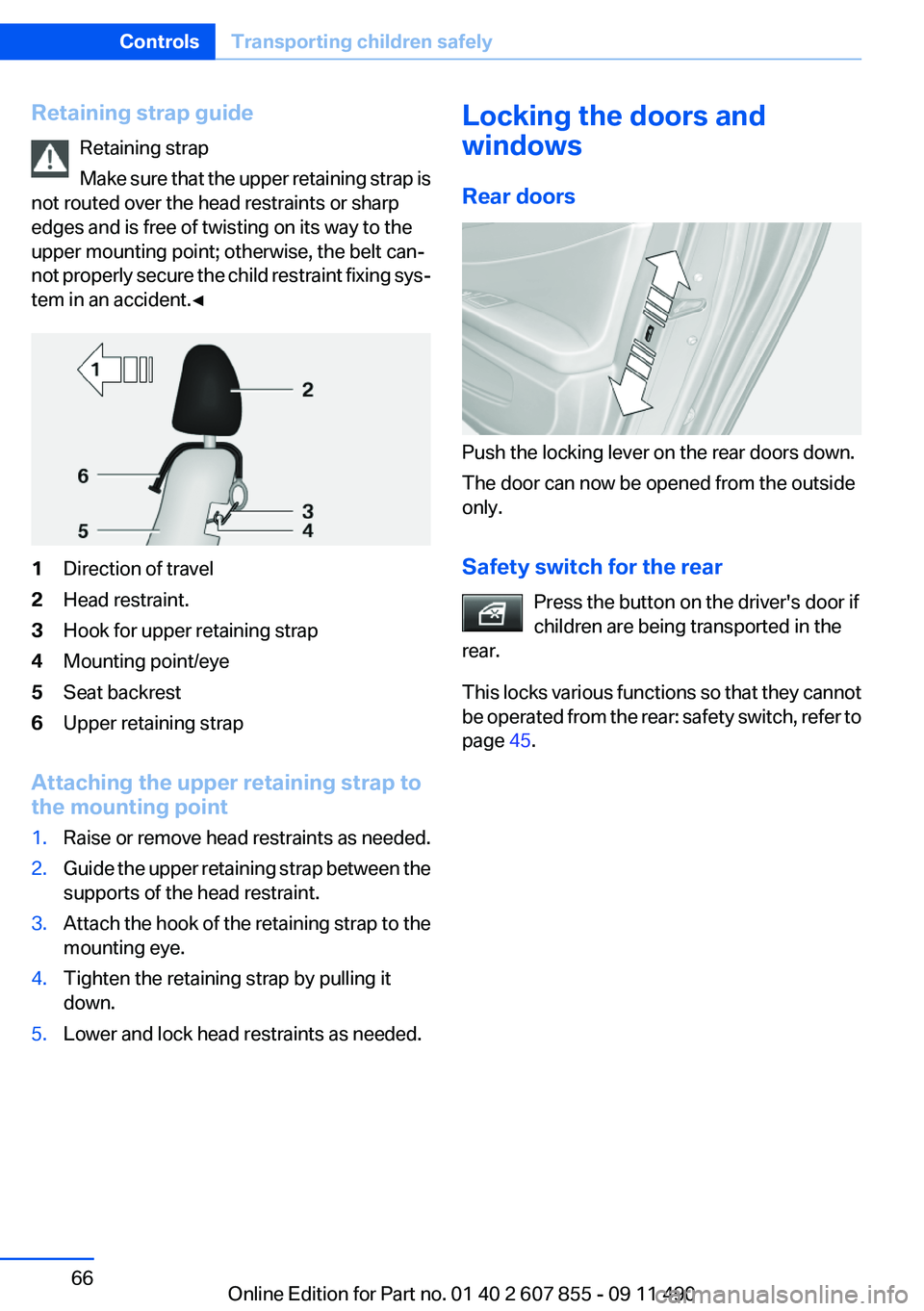
Retaining strap guideRetaining strap
Make sure that the upper retaining strap is
not routed over the head restraints or sharp
edges and is free of twisting on its way to the
upper mounting point; otherwise, the belt can‐
not properly secure the child restraint fixing sys‐
tem in an accident.◀1Direction of travel2Head restraint.3Hook for upper retaining strap4Mounting point/eye5Seat backrest6Upper retaining strap
Attaching the upper retaining strap to
the mounting point
1.Raise or remove head restraints as needed.2.Guide the upper retaining strap between the
supports of the head restraint.3.Attach the hook of the retaining strap to the
mounting eye.4.Tighten the retaining strap by pulling it
down.5.Lower and lock head restraints as needed.Locking the doors and
windows
Rear doors
Push the locking lever on the rear doors down.
The door can now be opened from the outside
only.
Safety switch for the rear Press the button on the driver's door if
children are being transported in the
rear.
This locks various functions so that they cannot
be operated from the rear: safety switch, refer to
page 45.
Seite 66ControlsTransporting children safely66
Online Edition for Part no. 01 40 2 607 855 - 09 11 490
Page 96 of 321
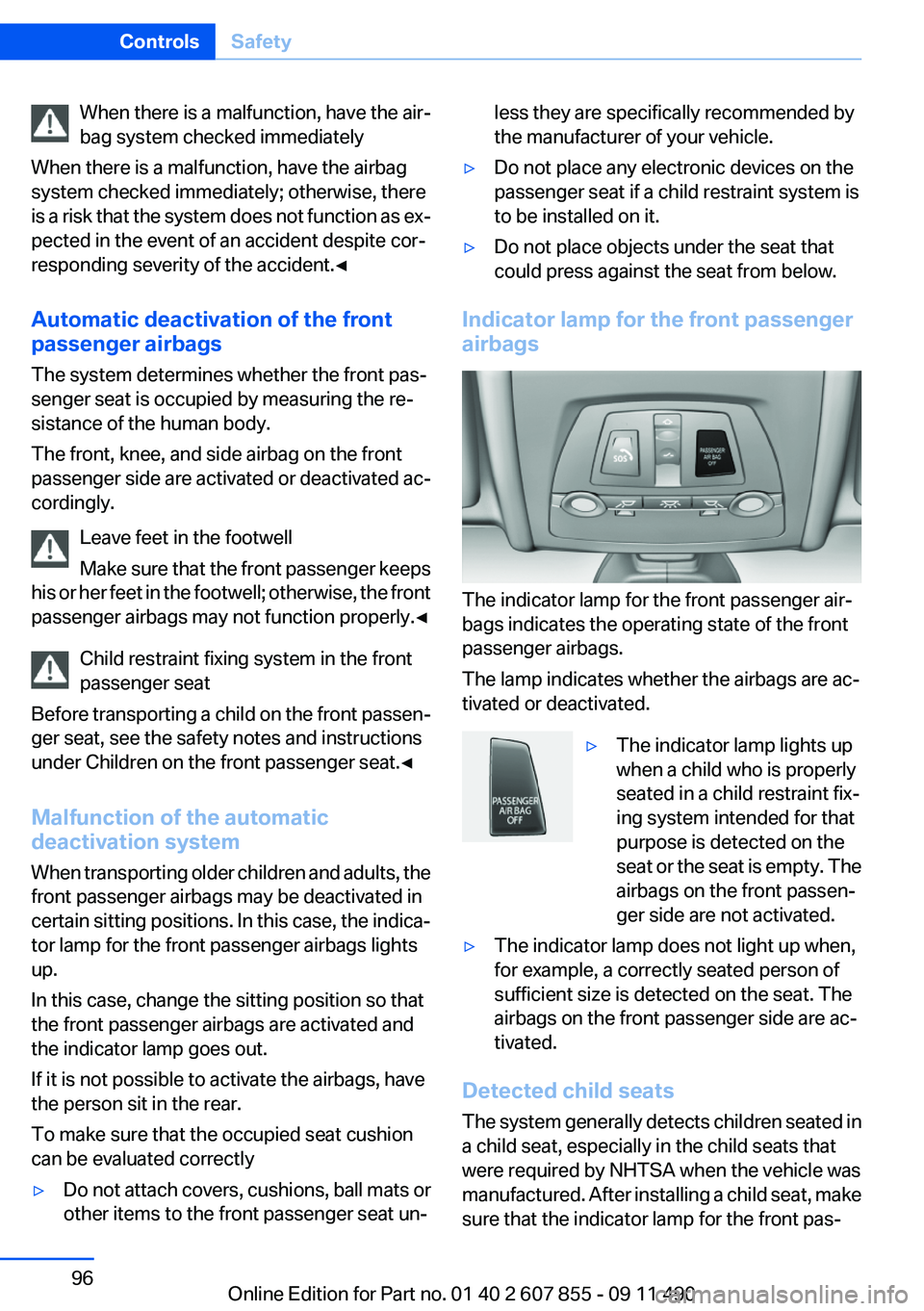
When there is a malfunction, have the air‐
bag system checked immediately
When there is a malfunction, have the airbag
system checked immediately; otherwise, there
is a risk that the system does not function as ex‐
pected in the event of an accident despite cor‐
responding severity of the accident.◀
Automatic deactivation of the front
passenger airbags
The system determines whether the front pas‐
senger seat is occupied by measuring the re‐
sistance of the human body.
The front, knee, and side airbag on the front
passenger side are activated or deactivated ac‐
cordingly.
Leave feet in the footwell
Make sure that the front passenger keeps
his or her feet in the footwell; otherwise, the front
passenger airbags may not function properly.◀
Child restraint fixing system in the front
passenger seat
Before transporting a child on the front passen‐
ger seat, see the safety notes and instructions
under Children on the front passenger seat.◀
Malfunction of the automatic
deactivation system
When transporting older children and adults, the
front passenger airbags may be deactivated in
certain sitting positions. In this case, the indica‐
tor lamp for the front passenger airbags lights
up.
In this case, change the sitting position so that
the front passenger airbags are activated and
the indicator lamp goes out.
If it is not possible to activate the airbags, have
the person sit in the rear.
To make sure that the occupied seat cushion
can be evaluated correctly▷Do not attach covers, cushions, ball mats or
other items to the front passenger seat un‐less they are specifically recommended by
the manufacturer of your vehicle.▷Do not place any electronic devices on the
passenger seat if a child restraint system is
to be installed on it.▷Do not place objects under the seat that
could press against the seat from below.
Indicator lamp for the front passenger
airbags
The indicator lamp for the front passenger air‐
bags indicates the operating state of the front
passenger airbags.
The lamp indicates whether the airbags are ac‐
tivated or deactivated.
▷The indicator lamp lights up
when a child who is properly
seated in a child restraint fix‐
ing system intended for that
purpose is detected on the
seat or the seat is empty. The
airbags on the front passen‐
ger side are not activated.▷The indicator lamp does not light up when,
for example, a correctly seated person of
sufficient size is detected on the seat. The
airbags on the front passenger side are ac‐
tivated.
Detected child seats
The system generally detects children seated in
a child seat, especially in the child seats that
were required by NHTSA when the vehicle was
manufactured. After installing a child seat, make
sure that the indicator lamp for the front pas‐
Seite 96ControlsSafety96
Online Edition for Part no. 01 40 2 607 855 - 09 11 490
Page 311 of 321

Band-Aids, refer to First aidkit 285
Bar for tow-starting/tow‐ ing 287
Basic position, rear seats 55
Bass 186
Battery replacement, remote control, rear entertain‐
ment 218
Battery replacement, vehicle battery 282
Battery replacement, vehicle remote control 30
Battery, vehicle 282
Belts, safety belts 56
Beverage holder, cu‐ pholder 152
Blinds, sun protection 46
Bluetooth audio 212
BMW Assist 249
BMW homepage 6
BMW Internet page 6
BMW Maintenance Sys‐ tem 276
BMW Search 251
Bottle holder, refer to Cu‐ pholder 152
Brake assistant 106
Brake assistant, adaptive 106
Brake discs, breaking in 158
Brake force display 105
Brake lamps, brake force dis‐ play 105
Brake lamps, bulb replace‐ ment 281
Brake lights, adaptive 105
Brake pads, breaking in 158
Braking, notes 159
Breakdown assis‐ tance 284, 285
Breaking in 158
Brightness of Control Dis‐ play 88
Bulb replacement 278
Bulb replacement, front 279
Bulb replacement, rear 281 Bulbs and lamps 278
Button, RES 116
Button, Start/Stop 67
Bypassing, refer to starting aid 285
C
Calendar 244
California Proposition 65 Warning 7
Camera, backup camera 130
Camera, care 292
Camera, Side View 131
Camera, Top View 127
Can holder, refer to Cu‐ pholder 152
Car battery 282
Car care products 290
Care, displays 292
Care, vehicle 290
Cargo 161
Cargo area 146
Cargo area, enlarging 147
Cargo area lid 38
Cargo area, storage compart‐ ments 153
Cargo partition 148
Cargo straps, securing cargo 162
Car key, refer to Remote con‐ trol 30
Carpet, care 291
Car wash 289
Catalytic converter, refer to Hot exhaust system 158
CBS Condition Based Serv‐ ice 276
CD/DVD 196
CD/DVD player, rear 217
CDs, storing 203
Cell phone 226
Center armrest 151
Center console 14
Central locking system 33 Central screen, refer to Control
Display 16
Changes, technical, refer to Safety 6
Changing parts 278
Changing wheels 282
Changing wheels/tires 267
Check Control 79
Checking the oil level 273
Children, seating position 63
Children, transporting safely 63
Child restraint fixing sys‐ tem 63
Child restraint fixing system LATCH 64
Child restraint fixing systems, mounting 63
Child safety locks 66
Child seat, mounting 63
Child seats 63
Chrome parts, care 291
Cigarette lighter 145
Cleaning, displays 292
Climate control 136
Climate control wind‐ shield 159
Clock 82
Closing/opening from in‐ side 37
Closing/opening via door lock 36
Closing/opening with remote control 34
Clothes hooks 153
Collision warning 120
Combination switch, refer to Turn signals 72
Combination switch, refer to Wiper system 73
COMFORT+ program, Driving Experience Switch 112
Comfort Access 41
COMFORT program, Driving Experience Switch 112
Computer 84 Seite 311Everything from A to ZReference311
Online Edition for Part no. 01 40 2 607 855 - 09 11 490
Page 314 of 321
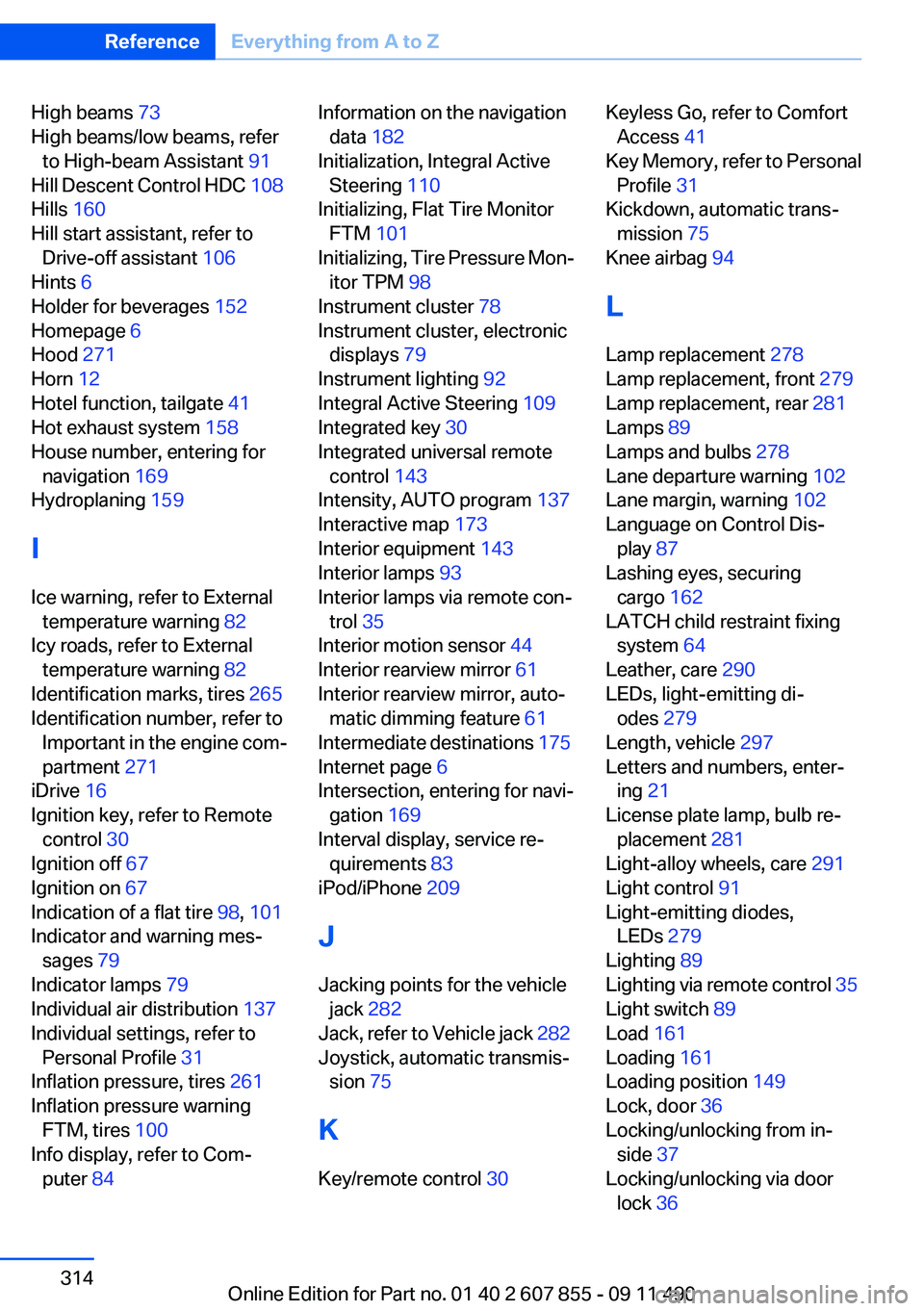
High beams 73
High beams/low beams, refer to High-beam Assistant 91
Hill Descent Control HDC 108
Hills 160
Hill start assistant, refer to Drive-off assistant 106
Hints 6
Holder for beverages 152
Homepage 6
Hood 271
Horn 12
Hotel function, tailgate 41
Hot exhaust system 158
House number, entering for navigation 169
Hydroplaning 159
I
Ice warning, refer to External temperature warning 82
Icy roads, refer to External temperature warning 82
Identification marks, tires 265
Identification number, refer to Important in the engine com‐
partment 271
iDrive 16
Ignition key, refer to Remote control 30
Ignition off 67
Ignition on 67
Indication of a flat tire 98, 101
Indicator and warning mes‐ sages 79
Indicator lamps 79
Individual air distribution 137
Individual settings, refer to Personal Profile 31
Inflation pressure, tires 261
Inflation pressure warning FTM, tires 100
Info display, refer to Com‐ puter 84 Information on the navigation
data 182
Initialization, Integral Active Steering 110
Initializing, Flat Tire Monitor FTM 101
Initializing, Tire Pressure Mon‐ itor TPM 98
Instrument cluster 78
Instrument cluster, electronic displays 79
Instrument lighting 92
Integral Active Steering 109
Integrated key 30
Integrated universal remote control 143
Intensity, AUTO program 137
Interactive map 173
Interior equipment 143
Interior lamps 93
Interior lamps via remote con‐ trol 35
Interior motion sensor 44
Interior rearview mirror 61
Interior rearview mirror, auto‐ matic dimming feature 61
Intermediate destinations 175
Internet page 6
Intersection, entering for navi‐ gation 169
Interval display, service re‐ quirements 83
iPod/iPhone 209
J
Jacking points for the vehicle jack 282
Jack, refer to Vehicle jack 282
Joystick, automatic transmis‐ sion 75
K
Key/remote control 30 Keyless Go, refer to Comfort
Access 41
Key Memory, refer to Personal Profile 31
Kickdown, automatic trans‐ mission 75
Knee airbag 94
L
Lamp replacement 278
Lamp replacement, front 279
Lamp replacement, rear 281
Lamps 89
Lamps and bulbs 278
Lane departure warning 102
Lane margin, warning 102
Language on Control Dis‐ play 87
Lashing eyes, securing cargo 162
LATCH child restraint fixing system 64
Leather, care 290
LEDs, light-emitting di‐ odes 279
Length, vehicle 297
Letters and numbers, enter‐ ing 21
License plate lamp, bulb re‐ placement 281
Light-alloy wheels, care 291
Light control 91
Light-emitting diodes, LEDs 279
Lighting 89
Lighting via remote control 35
Light switch 89
Load 161
Loading 161
Loading position 149
Lock, door 36
Locking/unlocking from in‐ side 37
Locking/unlocking via door lock 36 Seite 314ReferenceEverything from A to Z314
Online Edition for Part no. 01 40 2 607 855 - 09 11 490